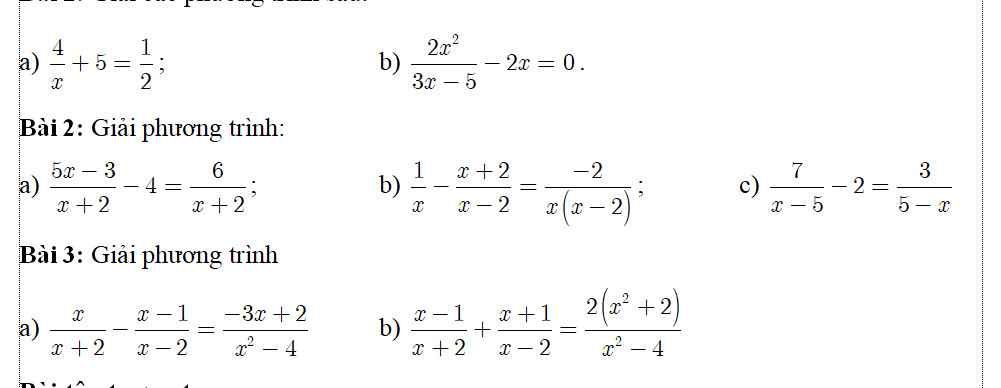Bài tập 3
Một gen có 2880 liên kết hiđrô và có hiệu số giữa nuclêôtit loại thymine với một loại nuclêôtit khác không bổ sung với nó bằng 240.
a) Tính số lượng nuclêôtit mỗi loại của gen.
b) Gen trên bị đột biến để hình thành gen mới có số liên kết hiđrô ít hơn một liên kết so với gen không bị đột biến nhưng có chiều dài của gen không đổi. Đột biến trên thuộc dạng nào? Tính số nuclêôtit mỗi loại của gen bị đột biến.
Hãy nhập câu hỏi của bạn vào đây, nếu là tài khoản VIP, bạn sẽ được ưu tiên trả lời.


Câu này có thể phân tích như sau:
**Ông bắt cậu bé học vẽ trứng gà mấy chục ngày liền làm cậu ta phát chán.**
- **Kiểu câu:** Câu này là câu phức có cấu trúc chủ ngữ + vị ngữ.
- **Phân tích ngữ pháp:**
- **Ông**: Chủ ngữ của câu, đứng đầu câu và là người thực hiện hành động.
- **bắt**: Động từ, diễn tả hành động của người nói.
- **cậu bé**: Tân ngữ, là đối tượng của hành động "bắt".
- **học vẽ trứng gà mấy chục ngày liền**: Động từ "học" đi kèm với tân ngữ "vẽ trứng gà mấy chục ngày liền", là hành động được bắt buộc phải làm.
- **làm cậu ta phát chán**: Cụm từ bổ nghĩa cho động từ "học", diễn tả kết quả của hành động làm cậu bé cảm thấy nhàm chán.
**Câu chuyện vẽ trứng của Đơ Vanh-xi cho người ta thấy chỉ ai chịu khó luyện tập động tác cơ bản thật tốt, thật tinh thì mới có tiền đồ.**
- **Kiểu câu:** Câu này là câu phức có cấu trúc chủ ngữ + vị ngữ.
- **Phân tích ngữ pháp:**
- **Câu chuyện vẽ trứng của Đơ Vanh-xi**: Chủ ngữ của câu, là người, sự vật, sự việc mà câu đề cập đến.
- **cho người ta thấy**: Động từ "cho" đi kèm với tân ngữ "người ta thấy", diễn tả hành động làm cho người khác nhận thức được điều gì đó.
- **chỉ ai chịu khó luyện tập động tác cơ bản thật tốt, thật tinh thì mới có tiền đồ**: Cụm từ bổ nghĩa cho động từ "cho thấy", diễn tả điều kiện để đạt được tiền đồ.
**Tổng kết:** Cả hai câu đều là câu phức, mỗi câu đều có một cấu trúc chủ ngữ + vị ngữ, và sử dụng các phần từ với vai trò khác nhau trong câu để diễn tả ý nghĩa.

\(a)\dfrac{5}{x+7}=\dfrac{-14}{x-5}\left(x\ne-7;x\ne5\right)\\ \Leftrightarrow-14\left(x+7\right)=5\left(x-5\right)\\ \Leftrightarrow-14x-98=5x-25\\ \Leftrightarrow5x+14x=-98+25\\ \Leftrightarrow19x=-73\\ \Leftrightarrow x=-\dfrac{73}{19}\left(tm\right)\\ b)\dfrac{3}{3x-2}=\dfrac{1}{x+1}\left(x\ne\dfrac{2}{3};x\ne-1\right)\\ \Leftrightarrow3\left(x+1\right)=3x-2\\ \Leftrightarrow3x+3=3x-2\\ \Leftrightarrow3=-2\)
=> Pt vô nghiệm
\(c)\dfrac{x}{x-2}=\dfrac{1}{x+1}+1\left(x\ne2;x\ne-1\right)\\ \Leftrightarrow\dfrac{x}{x-2}=\dfrac{x+2}{x+1}\\ \Leftrightarrow x\left(x+1\right)=\left(x-2\right)\left(x+2\right)\\ \Leftrightarrow x^2+x=x^2-4\\ \Leftrightarrow x=-4\left(tm\right)\)
\(d)\dfrac{x+6}{x+5}+\dfrac{3}{2}=2\left(x\ne-5\right)\\ \Leftrightarrow\dfrac{2\left(x+6\right)}{2\left(x+5\right)}+\dfrac{3\left(x+5\right)}{2\left(x+5\right)}=2\\ \Leftrightarrow\dfrac{2\left(x+6\right)+3\left(x+5\right)}{2\left(x+5\right)}=2\\ \Leftrightarrow2x+12+3x+15=4\left(x+5\right)\\ \Leftrightarrow5x+27=4x+20\\ \Leftrightarrow5x-4x=20-27\\ \Leftrightarrow x=-7\left(tm\right)\)
e: ĐKXĐ: x<>3
\(\dfrac{x+5}{x-3}+2=\dfrac{2}{x-3}\)
=>\(\dfrac{x+5+2x-6}{x-3}=\dfrac{2}{x-3}\)
=>3x-1=2
=>3x=3
=>x=1(nhận)
f: ĐKXĐ: \(x\notin\left\{0;-1\right\}\)
\(\dfrac{3x+5}{x+1}+\dfrac{2}{x}=3\)
=>\(\dfrac{3x+3+2}{x+1}+\dfrac{2}{x}=3\)
=>\(\dfrac{2}{x+1}+\dfrac{2}{x}=0\)
=>\(\dfrac{2x+2x+2}{x\left(x+1\right)}=0\)
=>4x+2=0
=>4x=-2
=>\(x=-\dfrac{1}{2}\left(loại\right)\)
g: ĐKXĐ: \(x\notin\left\{3;2\right\}\)
\(\dfrac{x+3}{x-2}+\dfrac{x+2}{x-3}=2\)
=>\(\dfrac{\left(x+3\right)\left(x-3\right)+\left(x+2\right)\left(x-2\right)}{\left(x-2\right)\left(x-3\right)}=2\)
=>\(\dfrac{x^2-9+x^2-4}{x^2-5x+6}=2\)
=>\(2\left(x^2-5x+6\right)=2x^2-13\)
=>-10x+12=-13
=>-10x=-25
=>\(x=\dfrac{5}{2}\left(nhận\right)\)
h: ĐKXĐ: \(x\notin\left\{2;3\right\}\)
\(\dfrac{2}{x-2}-\dfrac{3}{x-3}=\dfrac{3x-20}{\left(x-3\right)\left(x-2\right)}\)
=>\(\dfrac{2\left(x-3\right)-3\left(x-2\right)}{\left(x-2\right)\left(x-3\right)}=\dfrac{3x-20}{\left(x-3\right)\left(x-2\right)}\)
=>\(2x-6-3x+6=3x-20\)
=>3x-20=-x
=>4x=20
=>x=5(nhận)

8. Gọi số vé loại I và loại II lần lượt là x và y
ĐK: x,y > 0
Tổng số vé bán được là 500 vé `=> x+y=500` (1)
Tổng số tiền vé bán được là 44500000 đồng nên ta có pt:
`100000x+75000y=44500000`
`<=>4x+3y=1780` (2)
Từ (1) và (2) ta có hpt: \(\left\{{}\begin{matrix}x+y=500\\4x+3y=1780\end{matrix}\right.\Leftrightarrow\left\{{}\begin{matrix}x=280\\y=220\end{matrix}\right.\left(tm\right)\)
Vậy: ...

6. Gọi nhóm bạn trẻ có `x` (người)
ĐK: x ∈ N*
Mỗi người góp số tiền là: \(\dfrac{240}{x}\) (triệu)
Sau khi thêm thì tổng số người có trong nhóm là: \(x+2\) (người)
Sau khi thêm thì mỗi người góp: \(\dfrac{240}{x+2}\) (triệu)
Mà sau khi thêm người thì số tiền góp của mỗi người giảm đi 4 triệu nên ta có pt:
\(\dfrac{240}{x}-4=\dfrac{240}{x+2}\\ \Leftrightarrow\dfrac{240}{x}-\dfrac{240}{x+2}=4\\ \Leftrightarrow\dfrac{240\left(x+2\right)-240x}{x\left(x+2\right)}=4\\ \Leftrightarrow\dfrac{480}{x\left(x+2\right)}=4\\ \Leftrightarrow4x\left(x+2\right)=480\\ \Leftrightarrow x\left(x+2\right)=120\\ \Leftrightarrow x^2+2x-120=0\\ \Leftrightarrow\left(x-10\right)\left(x+12\right)=0\\ \Leftrightarrow\left[{}\begin{matrix}x=10\left(tm\right)\\x=-12\left(ktm\right)\end{matrix}\right.\)
Vậy: ...

a) R + R' = 5 + 6 = 11 > 18
=> (O) và (O') không giao nhau
b) R + R' = 9 + 3 = 12 > 2
=> (O) và (O') cắt nhau
c) R + R' = 8 + 5 = 13 = OO'
=> (O) và (O') tiếp xúc nhau
d) R + R' = 15 + 4 = 19 > 17
=> (O) và (O') cắt nhau

Bài 2:
\(a.\dfrac{5x-3}{x+2}-4=\dfrac{6}{x+2}\left(x\ne-2\right)\\ \Leftrightarrow\dfrac{5x-3}{x+2}-\dfrac{6}{x+2}=4\\ \Leftrightarrow\dfrac{5x-3-6}{x+2}=4\\ \Leftrightarrow\dfrac{5x-9}{x+2}=4\\ \Leftrightarrow5x-9=4\left(x+2\right)\\ \Leftrightarrow5x-9=4x+8\\ \Leftrightarrow5x-4x=8+9\\ \Leftrightarrow x=17\left(tm\right)\)
\(b.\dfrac{1}{x}-\dfrac{x+2}{x-2}=\dfrac{-2}{x\left(x-2\right)}\left(x\notin\left\{0;2\right\}\right)\\ \Leftrightarrow\dfrac{x-2}{x\left(x-2\right)}-\dfrac{x\left(x+2\right)}{x\left(x-2\right)}=\dfrac{-2}{x\left(x-2\right)}\\ \Leftrightarrow x-2-x\left(x+2\right)=-2\\ \Leftrightarrow x-2-x^2-2x=-2\\ \Leftrightarrow-x^2-x=0\\ \Leftrightarrow x\left(x+1\right)=0\\ \Leftrightarrow\left[{}\begin{matrix}x=0\left(ktm\right)\\x=-1\left(tm\right)\end{matrix}\right.\)
\(c.\dfrac{7}{x-5}-2=\dfrac{3}{5-x}\left(x\ne5\right)\\ \Leftrightarrow\dfrac{7}{x-5}-2-\dfrac{3}{x-5}=0\\ \Leftrightarrow\dfrac{7}{x-5}+\dfrac{3}{x-5}=2\\ \Leftrightarrow\dfrac{10}{x-5}=2\\ \Leftrightarrow x-5=\dfrac{10}{2}=5\\\Leftrightarrow x=5+5\\ \Leftrightarrow x=10\left(tm\right)\)
Bài 3:
a: ĐKXĐ: \(x\notin\left\{-2;2\right\}\)
\(\dfrac{x}{x+2}-\dfrac{x-1}{x-2}=\dfrac{-3x+2}{x^2-4}\)
=>\(\dfrac{x\left(x-2\right)-\left(x-1\right)\left(x+2\right)}{\left(x-2\right)\left(x+2\right)}=\dfrac{-3x+2}{\left(x-2\right)\left(x+2\right)}\)
=>\(x^2-2x-\left(x^2+x-2\right)=-3x+2\)
=>-3x+2=-3x+2
=>0x=0(luôn đúng)
Vậy: \(x\in R\backslash\left\{-2;2\right\}\)
b: ĐKXĐ: \(x\notin\left\{2;-2\right\}\)
\(\dfrac{x-1}{x+2}+\dfrac{x+1}{x-2}=\dfrac{2\left(x^2+2\right)}{x^2-4}\)
=>\(\dfrac{\left(x-1\right)\left(x-2\right)+\left(x+1\right)\left(x+2\right)}{\left(x+2\right)\left(x-2\right)}=\dfrac{2\left(x^2+2\right)}{x^2-4}\)
=>\(x^2-3x+2+x^2+3x+2-2x^2-4=0\)
=>0x=0(luôn đúng)
vậy: \(x\in R\backslash\left\{2;-2\right\}\)




